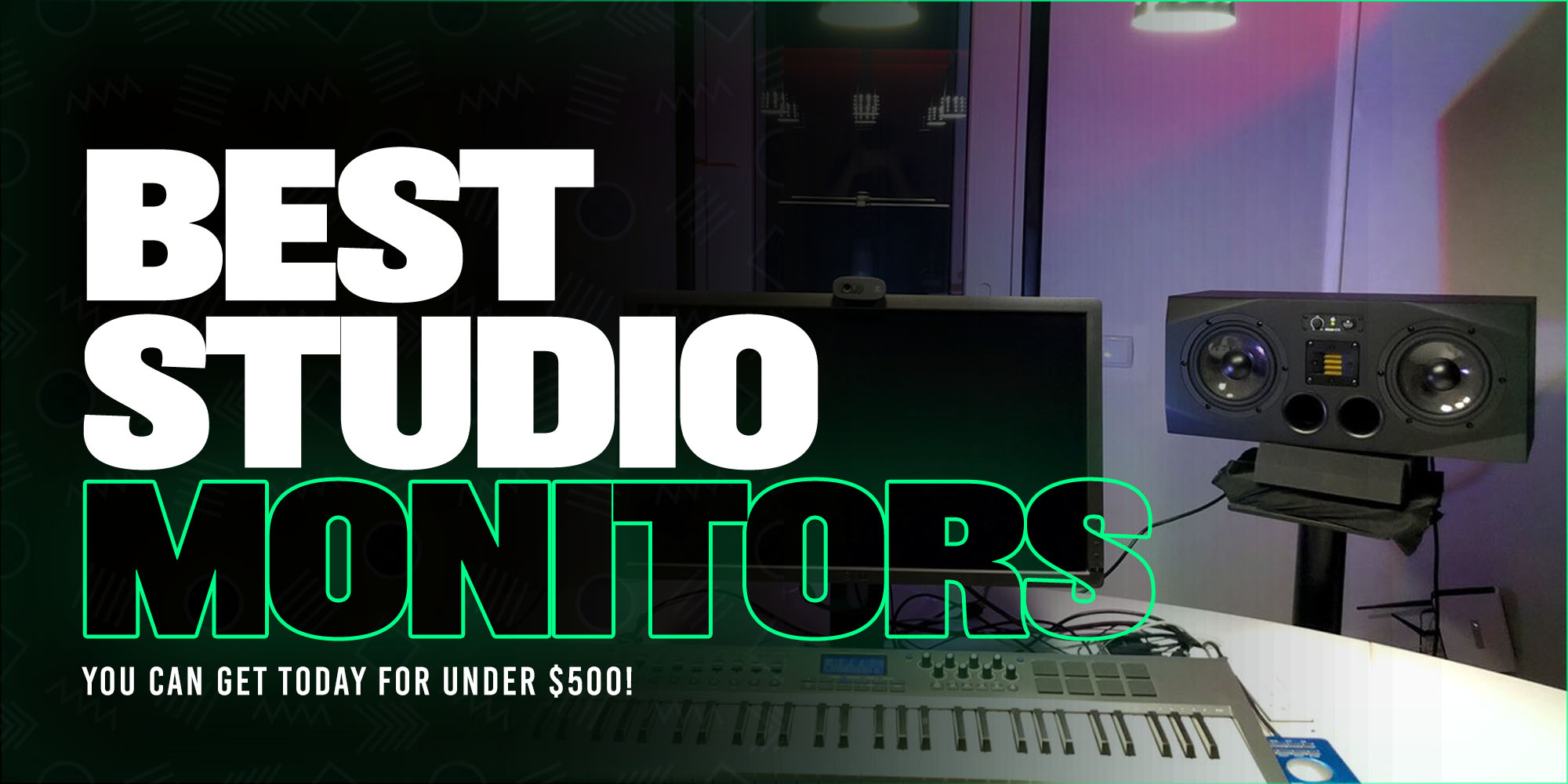
How to Find The Best Studio Monitor That Fits Your Budget
If you're in the market for some studio monitors on a budget, the good news is that you've got options.
Whether you're new to music production and looking for something to get started on or an experienced producer who wants a budget backup pair of studio monitors for a second studio, we've got you covered.
And with many options, becomes many comparisons, options, feature lists, and prices.
This can sometimes be overwhelming.
Most studio monitors come in at $500, so you'll have tons of options.
Be sure to check out our list of the best studio monitors under $200 if you have an even tighter budget.
Which studio monitors are the best for 500 dollars or less?
That's where we come in - because we tested all the most popular ones you would want to consider!
And we've made a list of the best ones you should consider taking a good look at.
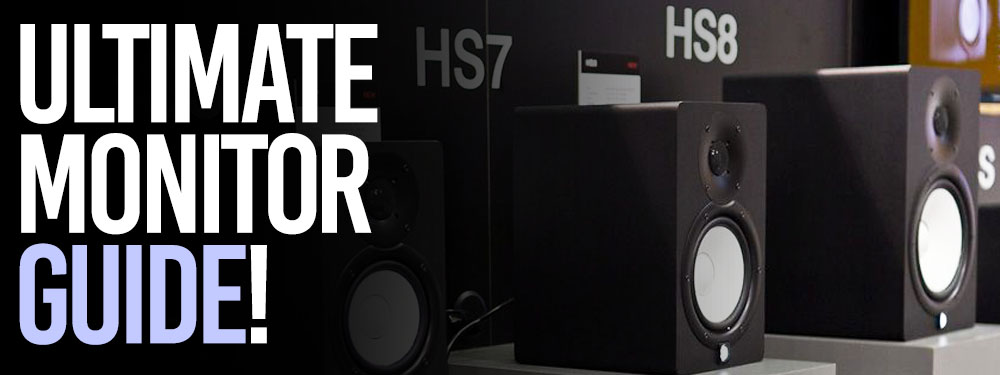
At the 500$ mark, you can expect to find solid studio monitors that bring both solid lows, mids, and highs.
You'll probably want to get a supplementary studio sub, like the KRK 10s.
Lots of these monitors will have good bass response although very little sub.
When we made this list, we were looking at the following criteria:
- Value for money
- Features
- Build Quality and Reliability
- Sound clarity
- Customer reviews
We've ranked the best studio monitors based on these criteria to help you determine which will work best for your studio space!
Bonus: check out our ultimate best studio monitor comparison, it goes into a lot more depth to better help you choose the right studio monitors.
11 Best Studio Monitors under $500: The Ultimate Guide
Time to get you a good set of studio monitors for a budget! To be clear, we're talking about 500$ for a pair of studio monitors, not the price per each.
These are the top 11 studio monitors under $500 at a glance:
Note that pricing for these changes all the time and depends on the region you're in - so be sure to look around and research them all.
You might find some deals that make one of these studio monitors more appealing than any of the other ones!
Let's dive deeper into each one, so you can decide which is the best fit for you.
Want to get your music on active & relevant playlists that actually get results?
Get your music heard now 👇
#11. ADAM Audio F7

The Adam Audio F7 is a pair of mid-range monitors made by one of the best names in the business.
In contrast to most other models they offer, what is particularly special about these speakers is their sophistication and high performance.
Among the features offered on this set is an extremely tight 7-inch low-frequency driver that provides excellent sound quality, not just nominal as it would be expected from its specifications; there’s also a large front-firing bass reflex port that helps push performance even further with careful design.
Here's an interesting video from ADAM explaining the difference between their high and low-end offerings, including the F7:
The tweeter type we find here is Hybrid Ribbon Design found on higher-end Adam Audio models which continues to add complexity and finesse to what could have been more traditional speakers for average users or professionals alike.
This is definitely a professional product for serious producers - and worth considering if you want to take your mixdowns up a notch.
Check out the Adam Audio F7's here.
#10. Kaly Audio LP-8
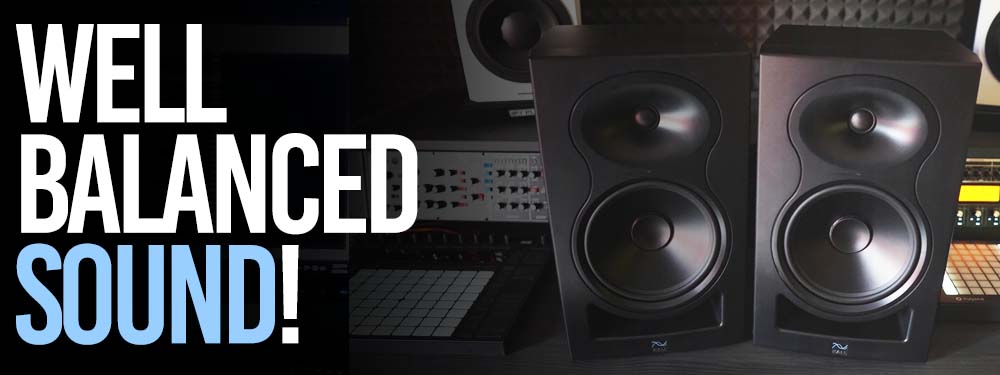
These monitors feature an 8-inch driver that delivers crisp sound and above-average frequency response.
These are some of the biggest studio monitors you'll find under 500$ - and they really do perform.
The only monitor that comes close in terms of size is the KRK Rokit 7's with their 7-inch drivers.
They’re extremely accurate and precise which may read as sounding too clinical to some listeners but not for us.
Accuracy in sound reproduction is balanced at the end of the day- nothing sounds better than balanced audio!
For their price point, it’s hard to imagine why anybody would settle for less than what these monitors have to offer: It’s an excellent value and we can't recommend them any less.
If there's one nitpick we have it's the slight background noise that occurs when turned on. Besides this minor detail, these monitors are a great choice.
Check out the Kaly Audio LP-8 monitors here.
#9. M-Audio BX5 D3
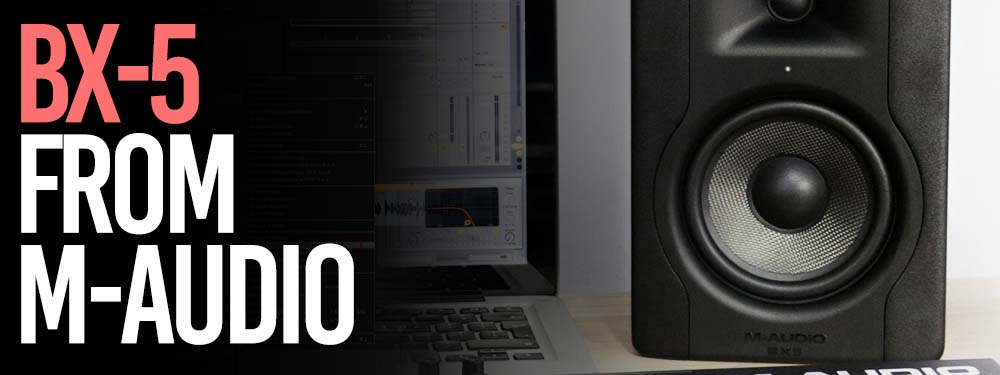
If you're after a set of monitors that are from a reputable brand, and have great response times and balance, these monitors might be the perfect fit for your studio.
The M-Audio BX5 features an adjustable high and low EQ to suit your sound space's needs.
They also have a rear port for richer sound quality with deep lows - great if you want more bass!
These D3 models have upgraded onboard Class AB bi-amplification and now deliver 60 Watts to the LF unit and 40 Watts to the HF unit. The crossover is set at 2.5kHz rather than 3kHz on Carbon models.
Also, these speakers come with a new look: The two-part front baffle offers M-Audio's signature rubberized feel as well as broader dispersion for an even wider listening sweet spot!
Here's a review of these monitors:
But if this pair is one size too big, look out for their smaller sibling: the M-Audio BX3!
Check out the M-Audio BX-5 monitors here.
#8. Tannoy Reveal 402

The Reveal 402 monitors by Tannoy may not be the newest, but they continue to hold up as reliable mix speakers.
The low cost is a bonus, these are one of the cheapest monitors on our list.
With the five-inch woofer in them, you can expect these to deliver on any low-end performance needs and interestingly enough we found them more accurate than the larger 802s from Tannoy!
It's actually quite amazing that you can get speakers of this quality at the price point we're looking at.
You're getting a frequency response of 56Hz to 48kHz, a 5-inch woofer and 1-inch tweeter, and 1x XLR, 1x 1/4”, 2x 1/8” inputs. The Tannoy 402 also includes a low-end EQ to push more bass towards the listener for a richer sound.
Sure, you might pick up on some deficiencies here and there with the sound, however, the overall frequency balance, imaging, and clarity for the price of these studio monitors exceed all expectations.
Check out the Tannoy Reveal 402 monitors here.
#7. Audioengine A5+ (Plus)

When you need some affordable punch for your audio setup, Audioengine’s A5+ Home Music System can do the trick.
While these are traditionally bookshelf speakers, their feature set, clarity, and overall value make it a great choice especially if you want to use your studio monitors for casual, enjoyable listening as well.
These speakers have a 5 inch composite driver and 0.75 inch silk dome tweeter with a frequency response of 50Hz to 22kHz that will surprise you, especially considering these are on the smaller size
If you need more bottom end, hook up a subwoofer to the variable LFE line output or if connectivity is important there's a 3 1/2 mm jack or Bluetooth with SBC, AAC, and aptX protocols.
These are a great studio monitor under 500 dollars to consider - they pack some solid bass without muddling the entire overall sound and are worth considering if you can get a good discount on them.
Check out the A5+ monitors here.
#6. Mackie CR5-X
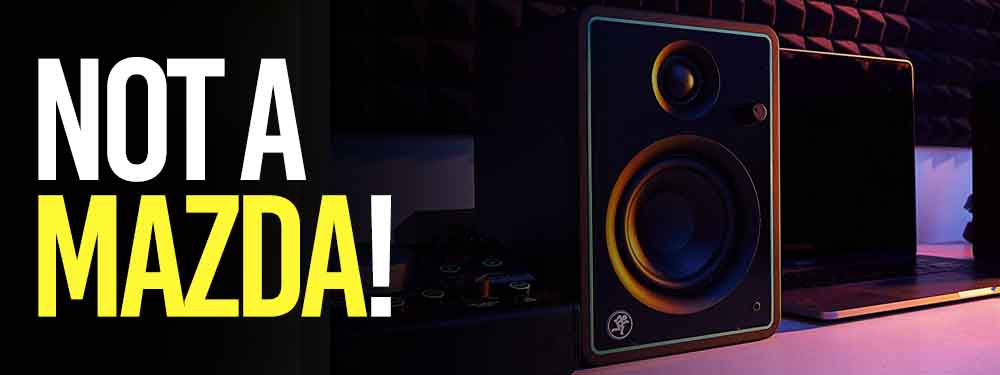
When it comes to high-end studio monitors, Mackie is near the top of the list.
The Mackie CR5-XBT offers a 5-inch polypropylene coated woofer, as well as a 0.75-Inch ferrofluid-cooled silk dome tweeter to deliver the high end.
Were surprised by how solid the speaker did with its frequency response of 69Hz to 20kHz (-3db).
The low end has enough depth for delivering smooth bass, and for those looking for clarity in general, there is plenty at the top tip without any distortion up until 20kHz where most monitors can't hold out past that point!
The brushed metal faceplate on the updated model adds a more sophisticated element as well as increases its premium feel compared to previous models.
The speaker position select feature that was present in earlier versions of this monitor is still available, which means you can control which side your volume knob will be situated on!
Not only does this offer flexibility not found with other monitors but it also helps when incorporating these speakers into your studio space, too.
These look great in a modern studio and they provide an excellent alternative to all those bland straight black monitors out there.
Check out the Mackie CR5-X monitors here.
#5. Samson M50
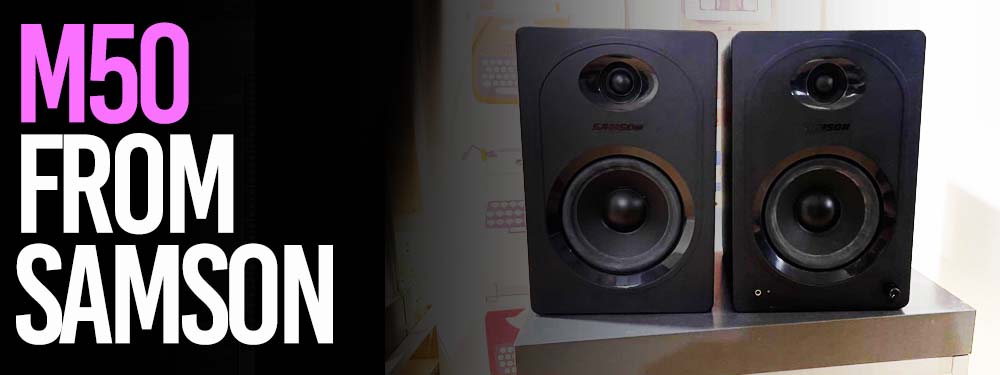
A great choice for beginners, Samson's M30s are a great well-balanced studio monitor that is perfect for starting your own home studio on a budget.
While these are pretty sizeable, we were also quite happy with smaller the Samson M30's which ranked on our list of the best studio monitors for a small room.
Here are the specs for the Samson M50:
- 5.25” Copolymer woofers with butyl surrounds
- ¾” silk dome high-frequency driver set in custom=designed waveguide
- Front panel volume control
- Front panel stereo 1/8” (3.5mm) headphone jack that will mute speakers when attached
- Rear panel RCA and 1/8” (3.5mm) inputs that accept -10dBV line level input
- 1/8” (3.5mm) stereo/sub output
- Solid MDF (Medium Density Fiberboard) construction
- Auto standby mode to reduce power consumption
- Built-in 40 X 2 watts (Peak) amp
Here's a quick review of the Samsons:
They're right in line with the others on this list - if you come by a deal or find a cheap used pair in good condition, it's worth pulling the trigger on getting them!
Check out the Samson M50 studio monitors here.
#4. Behringer MS16 Powered Studio Desktop Monitors
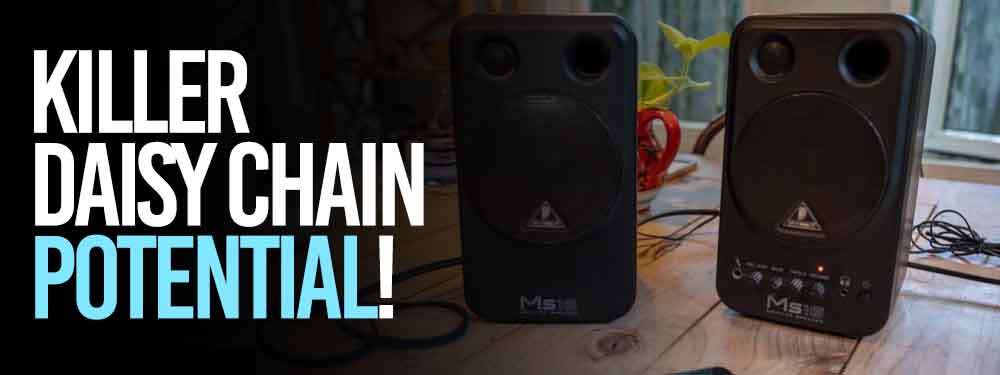
The Behringer MS16 Powered Studio Desktop Monitors set is another affordable desktop monitor set that is very suitable for multimedia in conjunction with vocal and music monitoring applications.
These have been on the market for a while, and for good reason - they're the old reliable affordable studio monitors.
Utilizing the 4" woofer and high-resolution tweeter equipped with two 8-watt amplifiers, this setup has bigger woofers than others on this list which in turn produces an accurate sound output for you to use for voice or music listening purposes.
While these are a bit smaller than the other monitors on this list, these are also 1) cheaper and 2) more portable - so these are great if those are factors you care about.
You can also daisy-chain these monitors with other Behringer products to increase the overall volume.
The Behringer MS16s have a nice, balanced sound with a slight emphasis on mids. They are also very versatile, with controls for treble, bass, and volume.
The large front panel also includes a headphone jack for private monitoring.
The Behringer MS16s are a good option if you want a dependable pair of affordable monitors that will last you a long time.
Check out the Behringer MS16 monitors here.
#3. PreSonus Eris E5
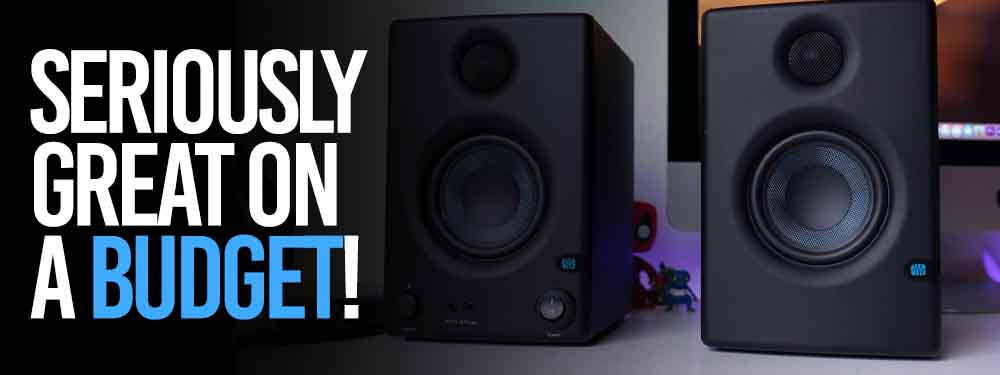
The PreSonus Eris 5-inch Monitor is one of the top brands out there and it's well worth a second look at, with many reviews speaking to its quality for the price.
The 5.25-inch woofer puts out a solid kick for its size! You'll likely need to make some adjustments to suit your space if you want the most of them.
Some may find having to tune these speakers an annoyance, but personally, I love being able to adjust the sound levels (remember not all studios are equal).
The PreSonus also has RF interference protection as well as noise isolation; plus Turn-On/Off transient protection so you can focus on your work without interruption!
The specs on these speakers are top-notch for the price.
The PreSonus E5 offers a frequency response of 53 Hz – 22 kHz which is comparable to other studio monitors at this size and price point. You’ll be able to hear all the details you’d expect from good studio monitors.
It also has an impressive max SPL, so you can use it in loud environments without worrying about blowing out your ears.
The E35 is a very affordable option and a great choice for beginners. When it comes to balancing price with sound clarity, these are a must to consider.
Check out the PreSonus monitors here.
#2. Yamaha HS5 Powered Studio Monitor
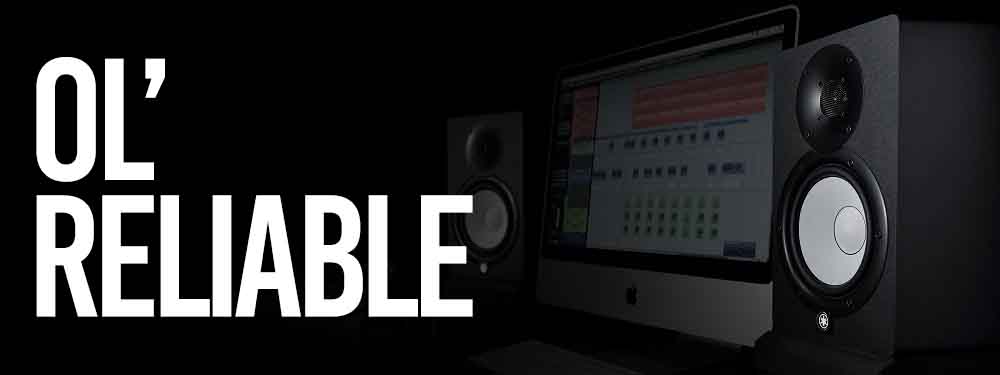
The HS5 model is designed to provide accurate monitoring in small rooms and is ideal for home studios.
It has a high maximum volume to compensate for the lack of acoustic treatment and low walls.
The HS5 has a 5” driver with a carbon fiber composite frame that delivers deep lows, smooth mids, and crisp highs.
The HS5's pivoting bass port lets you angle the speaker to compensate for room acoustics, and the included wall mount bracket lets you mount the HS5 on the wall to save space.
The HS5 has a single XLR input for connection to audio sources, and the rear panel has a volume control.
Weighing 12 pounds and measuring 7 x 9 x 12 inches, it’s not exactly a portable kind of monitor you can comfortably carry around with you.
The sweet spot is the low frequencies - you'll get a smooth response in both the low and mid-range.
This 2-way bass-reflex bi-amplified nearfield studio monitor utilizes both 5 inch cone woofer and 1 inch dome tweeter which enables it to handle a frequency response range of 54 Hz – 30 kHz respectively, as well as includes a low-frequency extension. You also get a room control switch.
Furthermore packed with several advanced features such as a low resonance enclosure design (prevents sound from bouncing back into the cabinet.)
Check out the Yamaha HS5 Powered Studio Monitor here.
#1. KRK ROKIT 7 G4
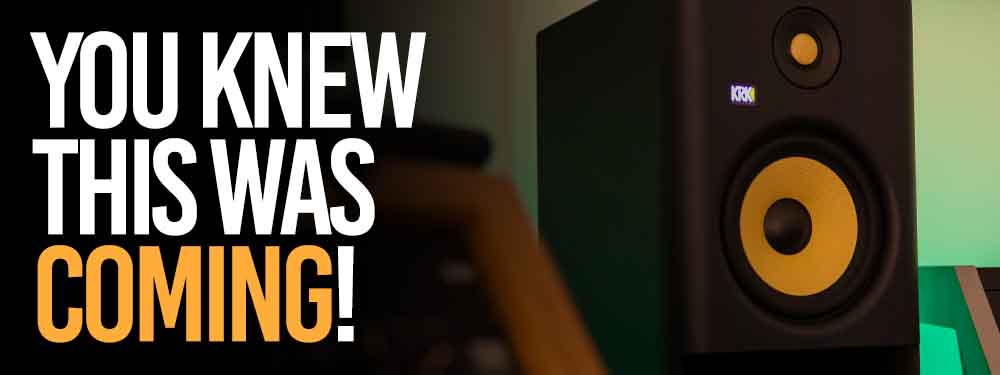
The KRK Rokit 7 G4 (Generation 4) is the most advanced speaker system from KRK that caters to professional studio-grade monitoring applications.
Unlike Generation 3 models, which are geared more towards casual listening and monitors, these speakers produce heavy mix bass sounds.
And the best part is how big these drivers are - this model sports some of the biggest drivers coming in at a massive 7 inches.
The bass port is revised and updated for this new generation - providing cleaner-sounding bass that's more balanced (and the front fascia of the monitor looks more modern as well).
These monitors won't be portable by any means - but by god, will you have lots of range and power to turn up in the studio
The low-end response is great thanks to the redesigned bass reflex port and low-distortion Kevlar drivers.
The speakers feature EQ switches and an LCD visual EQ on the back of each monitor, a big upgrade from the G3 model and we love using them.
As for the weightiness of these speakers: they’re heavier than others on this list.— so carrying them around won't work if portability matters for you!
The proprietary waveguide technology used in this model is optimized for better stereo sound - making it a good option for smaller spaces like music producers' studios or apartments.
Overall, when you're looking for audio equipment that can rival recording studio quality, the KRK Rokit 7 G4's among the best studio monitors you can find.
Check out the KRK ROKIT 7 G4 monitors here.
Studio Monitor Positioning and Placement for Studio monitors under $500
When you're using budget speakers in your setup, it's important you have the positioning and placement spot on to get the best sound possible.
It's easy to miss out on sonic clarity by not having an ideal studio setup.
Positioning your speaker properly is a form of room correction to help your monitors sound crisp and clear.

You want to make sure that your ear is not lined up with the same side of the monitors.
In all cases, you want to make sure that your ear is at least 2 feet away from the monitor.
Check out our ranking of the best studio monitors for a small room if you don't have a big studio space to work with.
Here's a video tutorial on proper studio monitor positioning:
How to Get a Flat Frequency Response with Budget Studio Monitors
It's important to get as flat a frequency response as possible and by making small changes to your room you can make studio monitors sound even better.
To get a flat frequency response in a small room, you can use many techniques:
- Acoustic panels
- Bass traps
- Sound diffusers
These all help minimize echo and unwanted resonant frequencies.
Acoustic panels are better at filtering out mid to high frequencies, while bass traps are more suited for low-frequency ranges.
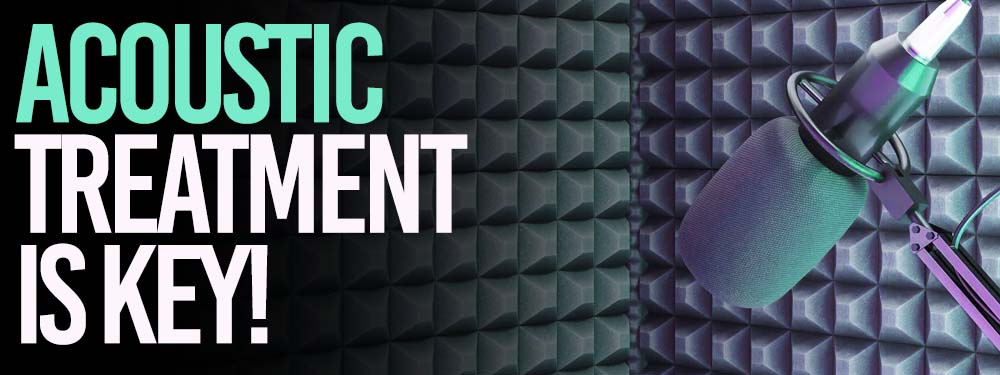
The purpose of sound diffusers is to soften the sound in a room and reduce reverb time.
Despite the variety of designs, all sound diffusers have one thing in common: they all have porous surfaces that scatter sound waves as they enter the material.
As a rule of thumb, the larger the surface area, the more effective the diffuser.
Depending on the shape of your room and desired treatment, you can choose from a variety of acoustic products such as fabric- or wood-based panels that come in an assortment of colors depending on your decor preferences.
Picking the right budget for studio monitors
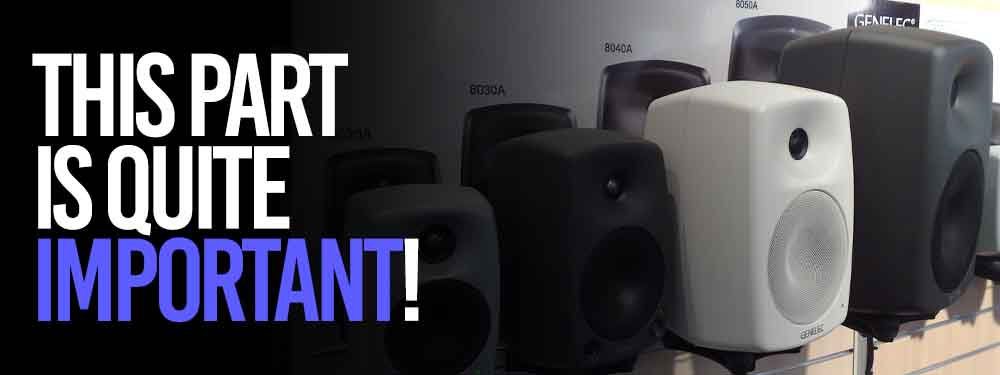
When it comes to picking the right studio monitors under $500, it's important to think about some important factors.
Driver size (or woofer size) is important. The bigger this is, the better your speakers will usually sound (and the more expensive).
The driver is the part of the speaker that produces sound, and each model will have varying sizes.
If you are purchasing new monitors, make sure to check their driver size.
Most drivers range from 5 to 10 inches, with some being as small as 3 inches.
At this price point, studio monitors will usually come at around 5 to 8 inch drivers tops.
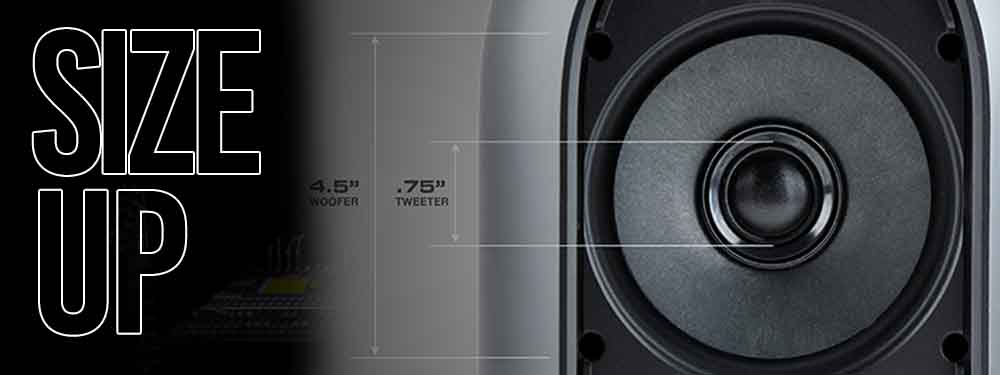
The smaller the drivers, the weaker the low frequencies in most cases.
The key is to find the sweet spot where you can hear as many sound frequencies as possible within your budget.
The wider the frequency response, the better.
This is why you should check the technical specifications of every studio monitor before purchasing one with good quality sound and a wide frequency response.
When you find it- whether that's by going through listings or reviews - then make an educated decision!
Picking budget Studio Monitors With a Good Frequency Range

When choosing a pair of budget studio monitors, one of the most important criteria to compare is the frequency range.
The majority of monitors will fall between 80 Hz and 20 kHz, which is the audible range for the human ear. However, some monitors can go as low as 40 Hz, and others can go as high as 30 kHz.
The lower the frequency range, the deeper the bass.
Usually, more expensive monitors will have more of a frequency range that includes deeper bass frequencies.
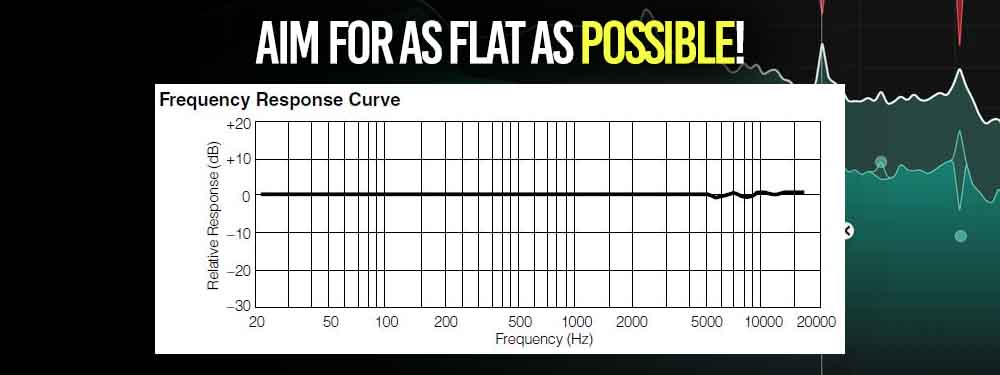
The higher the frequency range, the higher the treble. Depending on what you are recording, one may be more important than the other.
For accurately recording acoustic instruments, such as a piano or guitar, it is important to make sure that the monitors used have a high enough frequency range so they can reproduce the sound of those instruments.
It's also important to have studio monitors with low latency, or the delay between when you hear something and how long it takes for that sound to be reproduced.
Most are in the 10- 20 millisecond range but can vary depending on what is being heard.
It's always advised by experts never to mix or master using Bluetooth speakers since they hover around 100 milliseconds, which would throw everything off.
Avoid monitors that have a high distortion rate, as this will cause them to produce unnatural-sounding audio.
Lastly, you’ll want monitors with a wide dynamic range, which is the difference between the loudest and softest sound they can produce.
Why Frequency Response Matters for Budget Studio Monitors
The frequency response of a speaker is the range of sound that it can produce, from the lowest to the highest notes.
A speaker with excellent frequency response will be able to reproduce all notes within that range without any loss of quality.
The human ear can hear sounds within a range between 20 Hz and 20,000 Hz, but most people can only hear up to 16,000 Hz.
Low latency is an important feature to look for in studio monitors.
Alongside this, speakers with good frequency responses can provide a much better audio experience to many people who need it.
A speaker with poor frequency response will struggle to reproduce certain notes within the audible range of the human ear often resulting in distortion or reduced quality of sound over time.
Poor frequency responses can also lead to issues such as speaker distortion if not taken into account appropriately when purchasing a new set of speakers where high-quality frequencies are required for playback purposes.
Difference Between Studio Monitors vs. Speakers
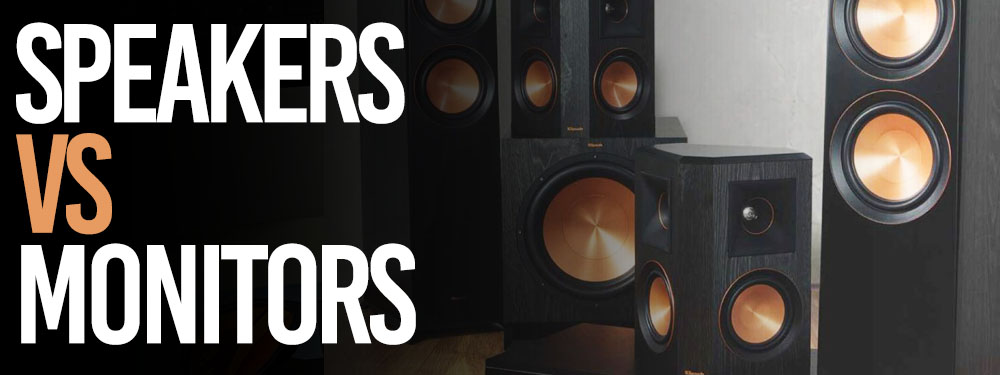
There are some significant differences between these two types, and knowledge will help you pick the best studio monitors for a small room.
Studio monitors are specially designed for audio production and recording. They have increased power handling, accurate response, and high-fidelity sound quality. This allows you to hear every detail of your work during the creative process.
On the other end of the spectrum, computer speakers are designed for casual listening to music and watching videos.
These two types of speakers have some major differences.
Studio monitors are meant for production because they have a flat response curve and a high level of detail.
Most of these monitors don't come with an amplifier, so you will need either a powered audio interface or a dedicated audio card with line-level input to record sound through those speakers.
Also, since studio monitors were designed for production work and not playback, their 1/4-inch input is larger than most computer speakers.
You can also connect dedicated speakers to your computer with a cable.
Once you’ve connected the speakers, you can adjust the volume with the computer’s software.
Because studio monitors have a flat response curve, you can hear every detail in your audio.
The best choice for you will depend on your specific needs.
Hopefully, this list and comparison have provided you with the information you need to make the right decision!
Get your music on playlists now.
It’s time you get your exposure and listeners up - playlisting by Boost Collective has been trusted by 50,000+ artists worldwide.
It’s easy: Search your song, get on playlists, and track your campaign.
What’re you waiting for? Tap in - and get added to playlists in 24 hours.
Join Boost Collective for free here.


